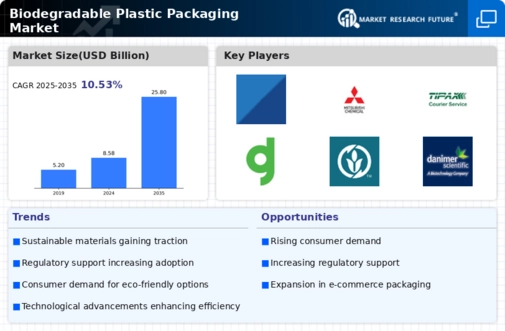Rising Environmental Awareness
The increasing awareness regarding environmental issues is a pivotal driver for the Biodegradable Plastic Packaging Market. Consumers are becoming more conscious of the ecological impact of traditional plastic packaging, which has led to a surge in demand for sustainable alternatives. This shift in consumer behavior is reflected in market data, indicating that the biodegradable plastic packaging segment is expected to grow at a compound annual growth rate of approximately 15% over the next five years. As individuals and organizations alike prioritize eco-friendly practices, the industry is likely to witness a significant transformation, with biodegradable options becoming a preferred choice for packaging solutions.
Government Regulations and Policies
Government regulations aimed at reducing plastic waste are significantly influencing the Biodegradable Plastic Packaging Market. Various countries are implementing stringent policies to limit the use of single-use plastics, thereby encouraging the adoption of biodegradable alternatives. For instance, recent legislation in several regions mandates the use of biodegradable materials in packaging, which is expected to propel market growth. Market data suggests that regions with strict regulations are likely to see a 20% increase in the adoption of biodegradable packaging solutions over the next few years. This regulatory landscape is creating a favorable environment for the industry to thrive.
Corporate Sustainability Initiatives
Many corporations are adopting sustainability initiatives as part of their corporate social responsibility strategies, which is driving the Biodegradable Plastic Packaging Market. Companies are increasingly recognizing the importance of reducing their carbon footprint and enhancing their brand image through sustainable practices. This trend is supported by market data showing that over 60% of consumers are willing to pay more for products packaged in environmentally friendly materials. As businesses strive to meet consumer expectations and regulatory requirements, the demand for biodegradable packaging solutions is anticipated to rise, fostering innovation and investment in this sector.
Technological Advancements in Production
Technological advancements in the production of biodegradable plastics are enhancing the viability of the Biodegradable Plastic Packaging Market. Innovations in material science are leading to the development of new biodegradable polymers that offer improved performance and cost-effectiveness. For example, advancements in biopolymer production techniques have resulted in materials that not only decompose more efficiently but also maintain the functional properties required for packaging. Market data indicates that the introduction of these technologies could reduce production costs by up to 30%, making biodegradable options more accessible to manufacturers and consumers alike.
Consumer Preference for Eco-Friendly Products
The growing consumer preference for eco-friendly products is a crucial driver for the Biodegradable Plastic Packaging Market. As consumers increasingly seek products that align with their values, the demand for biodegradable packaging solutions is on the rise. Market data reveals that nearly 70% of consumers are actively looking for sustainable packaging options when making purchasing decisions. This trend is prompting manufacturers to innovate and expand their product lines to include biodegradable materials, thereby enhancing their market competitiveness. The shift in consumer preferences is likely to continue shaping the industry landscape in the coming years.

















